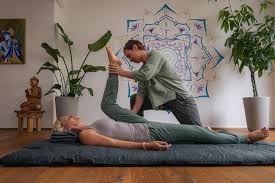Introduction
Originating in Thailand, Thai Yoga Massage is a therapeutic practice that combines elements of yoga, acupressure, and energy work. This ancient healing art focuses on balancing the body's energy pathways and promoting overall well-being. In this article, we'll explore the principles of Thai Yoga Massage, its benefits, and why it has become increasingly popular in the realm of holistic health.
The Principles of Thai Yoga Massage
1. Sen Energy Lines:
- Thai Yoga Massage is based on the concept of "sen" energy lines, similar to the principles of energy flow in traditional Chinese medicine. Practitioners use their hands, thumbs, and feet to apply pressure along these energy lines.
2. Yoga-Inspired Stretches:
- The recipient is guided through a series of passive yoga stretches, helping to improve flexibility, release tension, and enhance joint mobility.
3. Acupressure Points:
- Acupressure points are targeted to stimulate the body's natural healing abilities. The therapist uses their hands, elbows, and knees to apply pressure to specific points.
4. Mindful Breathing:
- Both the giver and receiver engage in deep, rhythmic breathing, promoting a sense of relaxation and mindfulness throughout the session.
Benefits of Thai Yoga Massage
1. Improved Flexibility:
- The yoga-inspired stretches in Thai Yoga Massage contribute to increased flexibility and range of motion.
2. Stress Reduction:
- The combination of acupressure and gentle stretches helps release tension, promoting relaxation and stress reduction.
3. Enhanced Energy Flow:
- By working on the sen energy lines, Thai Yoga Massage aims to restore the natural flow of energy in the body, fostering balance and vitality.
4. Pain Relief:
- The targeted pressure on acupressure points can alleviate muscle and joint pain, providing relief from chronic discomfort.
5. Improved Circulation:
- The massage techniques used in Thai Yoga Massage can enhance blood circulation, promoting better oxygenation of tissues and overall cardiovascular health.
What to Expect During a Thai Yoga Massage Session
-
Comfortable Attire:
- Clients wear loose, comfortable clothing to allow for ease of movement during the session.
-
Floor Mat Setting:
- Thai Yoga Massage is typically performed on a mat on the floor. The recipient lies down while the practitioner uses hands, feet, and knees to apply pressure and guide through stretches.
-
Customized Approach:
- Each session is tailored to the individual's needs, with the practitioner adjusting the intensity of stretches and pressure based on the client's comfort level.
-
Mindful Atmosphere:
- The session incorporates mindfulness and deep breathing, creating a serene and calming atmosphere.
Precautions and Considerations
While Thai Yoga Massage is generally safe, it may not be suitable for everyone. Individuals with certain health conditions, such as recent injuries or specific medical concerns, should consult with a healthcare professional before undergoing a session.
Conclusion
Thai Yoga Massage offers a unique and holistic approach to well-being, combining the benefits of yoga, acupressure, and energy work. Whether seeking relaxation, pain relief, or improved flexibility, this ancient healing art provides a rejuvenating experience for both the body and mind. As with any therapeutic practice, it's essential to communicate openly with the practitioner to ensure a safe and tailored session that meets individual needs.
FAQs (Frequently Asked Questions)
-
Is Thai Yoga Massage painful?
- Thai Yoga Massage should not be painful. The practitioner adjusts the pressure and intensity of stretches based on the client's comfort level.
-
How long does a typical Thai Yoga Massage session last?
- Sessions can vary in length, but they often last between 60 to 90 minutes.
-
Can anyone receive a Thai Yoga Massage?
- While generally safe, individuals with certain health conditions should consult with a healthcare professional before undergoing a Thai Yoga Massage session.
-
Is it necessary to have prior yoga experience for Thai Yoga Massage?
- No prior yoga experience is required. The practitioner guides the recipient through passive stretches, and the session is adapted to the individual's level of flexibility.
-
How often is it recommended to receive Thai Yoga Massage?
- The frequency of sessions can vary based on individual needs. Some people benefit from regular sessions, while others may find occasional sessions beneficial for maintenance and relaxation.


No comments yet